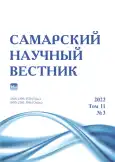Особенности баланса экосистемных услуг и рисков для древесных растений в насаждениях г. Самары
- Авторы: Заика А.С.1,2, Кавеленова Л.М.2
-
Учреждения:
- Научно-исследовательский институт садоводства и лекарственных растений «Жигулёвские сады»
- Самарский национальный исследовательский университет имени академика С.П. Королёва
- Выпуск: Том 11, № 3 (2022)
- Страницы: 41-47
- Раздел: Биологические науки
- URL: https://bakhtiniada.ru/2309-4370/article/view/114878
- DOI: https://doi.org/10.55355/snv2022113104
- ID: 114878
Цитировать
Полный текст
Аннотация
Развитие концепции экосистемных услуг, начатое в конце XX века преимущественно зарубежными авторами, в последнее время распространяется на рассмотрение различных сторон взаимодействия человечества с окружающими природными комплексами, включая функционирование агроэкосистем различного типа и урбосреды. В городской экосистеме представлены различные формы инфраструктуры, предоставляющие услуги населению, включая зеленую инфраструктуру, состоящую из естественных растительных систем и связанных с ними зеленых технологий. Зеленая инфраструктура обеспечивает реализацию регулирующих, поддерживающих и культурных экосистемных услуг. С другой стороны, в последнее время рассматривается обратное взаимодействие – появилась практика рассмотрения экосистемных услуг, оказываемых непосредственно урбосредой, для сохранения биологического разнообразия. Оказание экосистемных услуг является важной ролью городских насаждений, причем особо важен вклад древесных растений в их реализацию. Несмотря на небольшую долю площади, занимаемой в урбосреде, использование земель, покрытых деревьями, способствует существенному уменьшению «экологического следа» города. Однако качество оказываемых экосистемных услуг во многом определяется жизненным состоянием тех или иных экземпляров деревьев и зависит от их видовых особенностей. На основе фактических данных, полученных в ходе обследования модельных участков уличных насаждений г. Самары, авторами рассматриваются особенности баланса между экосистемными услугами и рисками, связанными с видовым составом и жизненным состоянием древесного компонента насаждений в урбосреде. Для ряда видов древесных растений пофакторно проанализирована их актуальная роль в урбосреде с учетом эффективности реализации экосистемных услуг и выраженности проблем, связанных с их состоянием либо с особенностями жизнедеятельности.
Полный текст
Открыть статью на сайте журналаОб авторах
Анна Сергеевна Заика
Научно-исследовательский институт садоводства и лекарственных растений «Жигулёвские сады»; Самарский национальный исследовательский университет имени академика С.П. Королёва
Email: zaika_anna96@mail.ru
научный сотрудник; аспирант кафедры экологии, ботаники и охраны природы
Россия, г. Самара; г. СамараЛюдмила Михайловна Кавеленова
Самарский национальный исследовательский университет имени академика С.П. Королёва
Автор, ответственный за переписку.
Email: lkavelenova@mail.ru
доктор биологических наук, профессор, заведующий кафедрой экологии, ботаники и охраны природы
Россия, г. СамараСписок литературы
- Costanza R., d'Arge R., De Groot R. et al. The value of the world's ecosystem services and natural capital // Nature. 1997. Vol. 387 (6630). P. 253–260.
- Daily G. Nature's services: societal dependence on natural ecosystems. Washington: Island Press, 1997. 392 p.
- De Groot R.S., Wilson M.A., Boumans R.M. A typology for the classification, description and valuation of ecosystem functions, goods and services // Ecological Economics. 2002. Vol. 41. P. 393–408.
- McKenzie T. Environmental Innovations in Urban Ecosystems // Introduction to Agroecology / C. Caldwell, S. Wang (eds). Singapore: Springer, 2020. P. 237–258. doi: 10.1007/978-981-15-8836-5_18.
- Banerjee A., Meena R.S., Jhariya M.K., Yadav D.K. Agroecological footprints management for sustainable food system. Singapore: Springer, 2021. 518 p. doi: 10.1007/978-981-15-9496-0.
- Breuste J., Pauleit S., Haase D., Sauerwein M. Urban ecosystems: function, management and development. Berlin; Heidelberg: Springer, 2021. 339 p. doi: 10.1007/978-3-662-63279-6.
- Grunewald K., Bastian O. Ecosystem services – concept, methods and case studies. Berlin; Heidelberg: Springer, 2015. 319 р. doi: 10.1007/978-3-662-44143-5.
- Hall M.H.P., Balogh S.B. Understanding urban ecology: an interdisciplinary systems approach. Cham: Springer, 2019. 368 p. doi: 10.1007/978-3-030-11259-2.
- van Bueren E., van Bohemen H., Itard L., Visscher H. Sustainable urban environments: an ecosystem approach. Dordrecht: Springer, 2012. 436 p. doi: 10.1007/978-94-007-1294-2.
- Экологический след субъектов Российской Федерации. Основные выводы и рекомендации. М.: WWF России, 2017. 72 с.
- A catalogue of ecosystem services in Slovakia: benefits to society / P. Mederly, J. Cernecky (eds). Cham: Springer, 2020. 259 р. doi: 10.1007/978-3-030-46508-7.
- Sabogal A. Urban ecology: a case study of Lima city, Peru. Cham: Springer, 2021. 175 p. doi: 10.1007/978-3-030-69905-5.
- Boyd J., Banzhaf S. What are ecosystem services? The need for standardized environmental accounting units // Ecological Economics. 2007. Vol. 63. P. 616–626.
- Catalano C., Andreucci M.B., Guarino R., Bretzel F., Leone M., Pasta S. Urban services to ecosystems: green infrastructure benefts from the landscape to the urban scale. Cham: Springer, 2021. 536 p. doi: 10.1007/978-3-030-75929-2.
- Haines-Young R., Potschin M. The links between biodiversity, ecosystem services and human well-being // Ecosystem ecology: a new synthesis. Cambridge: Cambridge University Press, 2010. P. 110–139.
- Fisher B., Turner R.K. Ecosystem services: classification for valuation // Biological Conservation. 2008. Vol. 141. P. 1167–1169.
- Roy S., Byrne J., Pickering C. А systematic quantitative review of urban tree benefits, costs, and assessment methods across cities in different climatic zones // Urban Forestry and Urban Greening. 2012. № 11. P. 351–363.
- Marzluff J., Shulenberger E., Endlicher W., Alberti M., Bradley G., Ryan C., ZumBrunnen C., Simon U. Urban ecology: an international perspective on the interaction between humans and nature. New York: Springer, 2008. 802 p.
- Букварёва Е.Н., Замолодчиков Д.Г. Экосистемные услуги России: прототип национального доклада. Т. 1. Услуги наземных экосистем. М.: Изд-во Центра охраны дикой природы, 2016. 148 с.
- Алексеев В.А. Диагностика жизненного состояния деревьев и древостоев // Лесоведение. 1989. № 4. С. 51–57.
- Майдебура И.С., Чупахина Г.Н. Оценка жизненного состояния древоcтоя в условиях города // Вестник РГУ им. И. Канта. 2007. Вып. 1. Естественные науки. С. 88–97.
- Заика А.С., Кавеленова Л.М. Эффективность реализации различных экологических услуг компонентами системы озеленения г. Самары // Экологический сборник 7: тр. молодых ученых (г. Тольятти, 18–21 апреля 2019 г.) / под ред. С.А. Сенатора, О.В. Мухортовой, С.В. Саксонова. Тольятти: ИЭВБ РАН, «Анна», 2019. С. 172–175. doi: 10.24411/9999-010A-2019-10040.
- Кавеленова Л.М., Розно С.А., Хныкина А.С. Деревья в озеленении города: к концепции баланса «экологические услуги / проблемы, расходы, риски» // Экология родного края: проблемы и пути их решения: мат-лы ХIII всерос. науч.-практ. конф. c междунар. участием. Кн. 1 (23–24 апреля 2018 г.). Киров: ВятГУ, 2018. С. 111–114.
- Об утверждении муниципальной программы городского округа Самара «Озеленение территории городского округа Самара» на 2013–2017 годы: постановление Администрации городского округа Самара от 18.12.2012 № 1627 [Электронный ресурс] // Электронный фонд правовых и нормативно-технических документов. https://docs.cntd.ru/document/464000574.
Дополнительные файлы












